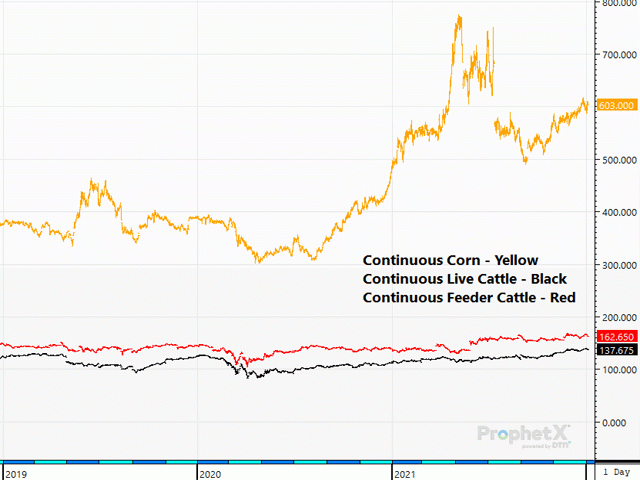Call the Market
What $6 Corn Means for the Cattle Market
When it comes to understanding markets, it's far too costly to look at things from a simple, singular perspective. What may be good for today could be the dismay of tomorrow, and what seems supportive long term usually comes as bitter pill to swallow today. When it comes to weathering the blows of the market, it's vital to understand that there is always a long- and short-term game being played, and both are inherently important to understand. While Tuesday's advancement to $6.00 per bushel corn came as a heavy load to bear, there could be some good that comes from the corn's expensive price tag.
To preface the market's current environment, on Jan. 4, 2022, cattlemen were in for a rude awakening as most thought that the market was going to stroll into the new year. However, within a few short minutes of seeing the market trade, feeders fell out of bed and began trading $3 to $4 lower while the corn market shot up $0.16 to $0.20 and soybeans jumped $0.30 to $0.34. The rally in the grain markets was largely influenced by the poor weather conditions in South America. With both Brazil and Argentina desperate for moisture, it's unlikely their crops will amount to much, which means that U.S. crops could have a bumper year due to strong export demand.
The negative implications of higher priced corn are obvious and typically what come to mind first. So, let's spend some time breaking down both the positive and negative consequences of the spike in these feed prices.
P[L1] D[0x0] M[300x250] OOP[F] ADUNIT[] T[]
First, the onset of higher corn prices will likely influence feedlots to market the pens of market-ready cattle at lighter weights. Based on the most recent actual slaughter data released from USDA, for the week ending Dec. 18, 2021, steer carcasses averaged 924 pounds, which is 5 pounds lower than the week before, but still 3 pounds heavier than a year ago; heifers averaged 850 pounds, which is 1 pound lighter than the previous week, but still 3 pounds heavier than a year ago.
There's no doubt that, come the end of January when the newest Cattle Inventory report is released, we will see a stark drop off in beef cow numbers, which bodes positively for cow-calf producers amid such high beef demand. However, if carcass weights continue to pressure the market at these ginormous levels, what happens if something happens to production levels and packers run slower chain speeds? The added tonnage will glut the market and cattle supplies will once again begin to back up and ultimately minimize the rally that the cattle market could have had if feedlots were current.
Second, high corn prices can be stomached as long as the cattle contracts rally along with them. If you're savvy from being in the cattle business for long, you've probably heard the old saying "high corn makes for high cattle." While most people initially raise an eyebrow at that saying when thinking about it from a dollars-and-cents standpoint, time has shown us that there is a lot of truth behind it. Historically speaking, the cattle contracts traded in an inverse manner to the corn market, and from a day-to-day perspective, feeders are heavily influenced by what the corn market is doing. In recent years, however, the cattle complex has become less reactionary to the corn market's sporadic trading, and long-term higher corn can influence cattle prices to trend higher. For a visual perspective, see the chart with this column.
The problem with high corn prices is that it pressures feedlots' cost of gains, and amid a year when drought has crippled wheat fields and sent hay prices through the roof, finding a way to feasibly feed cattle is growing more and more difficult. Being in the cattle feeding business is by no means an easy profession and the onset of sharply higher corn prices has only made the task tougher.
In conclusion, the market still has much to be bullish about, but it's inevitable that hurdles will present themselves throughout the year. Throughout the past week, parts of the U.S. have been blessed with snow, which will hopefully continue to accumulate throughout this winter and help areas affected by drought. When feed costs become this extravagant, knowing your costs becomes even more important, and all expenses must be monitored.
ShayLe Stewart can be reached at ShayLe.Stewart@dtn.com
(c) Copyright 2022 DTN, LLC. All rights reserved.




